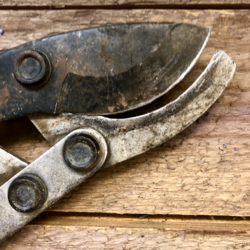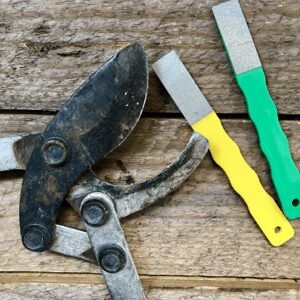How to Sharpen Pruners, Loppers and Shears
A Guide for Gardening Tools and Blade Sharpening
Sharpening Garden Tools
In my first post on Sharpening Scissors, I showed you a quick and easy way to sharpen your garden scissors with my favorite sharpening tool: the diamond hone sharpening paddle. This guide will give you some insight and techniques to keep your garden tools (pruners, loppers and shears) sharp and in tip top shape for the garden. Sharpening pruners and loppers can be difficult due to the curved blade if you don’t have the right tools and technique. I guess you are asking: Aren’t they sharp enough? Most gardeners will not maintain their tools, and just go on using dull, ineffective blades. But clean cuts are imperative to keeping your plants healthy, and a sharp set of tools makes garden that much more fun, and reduces the time to prune and cut.
Sharpen your loppers to get a clean slicing of the branch material. If you examine the cut and there is crushed plant material, the loppers are not sharp and need some more honing of the garden tool blade.
Steps for Sharpening Pruners and Other Curved Blade Tools
Clean your blades. We have to get to the steel before we can sharpen. Cleaning the gunk off the blades can help tool function immediately, and the sap dirt and grime can harden over time and make your tools almost useless. You can clean your pruners with dish soap, warm water and a brush or scrubbing sponge. For dried sap on the blades, scrubbing bubbles will help break down the sticky stuff.
Remove rust. You can remove rust by soaking the blades in white vinegar overnight. For stubborn, rusted blades you can also use a wire brush to remove the oxidized metal.

File down large nicks. The sharpening process requires a move from coarse to fine. If you have diamond stone paddles, it makes the process simple. Grab your coarse paddle and run it over the blades at an angle equal to the existing bevel. Focus on any damage areas to smooth out the blade curve. The coarse paddle will remove the top layer of metal and get you to the good shiny stuff. Make sure and get both sides of the blade, but on the flat part, keep your hone flat and just do a few passes.
Sharpening time. Call me strange, but I love this part. Take your medium grit hone and run it over your blade. After a few passes, you will start to feel the metal get smoother, and your blade will begin to sharpen. After quite a few passes of the sharpener, switch to your fine diamond paddle. This will really put a shine to the blade and start to really put that cutting edge in shape. As you sharpen one side of the blade, it will build up a burr on the backside. Make sure and do a few strokes to remove this.
A bit of oil. When sharpening your garden tools, its a great opportunity to lubricate the joints for smooth operation. I use regular sewing machine oil, and just put a few drops on the pruner or lopper nut. Also take a rag and put a drop or two of oil on, and run it over your sharpening work. This will protect the blade from rust and keep the sap from sticking.
Conclusion – Sharpen Those Shears Now
And that’s it, simple and effective. Now go enjoy your work! We carry the diamond stone paddles for sharpening in our store, and you can find them here:
Garden Tool Sharpening KitWant to see our buying guide for garden hand pruners? Click below:











You must be logged in to post a comment.